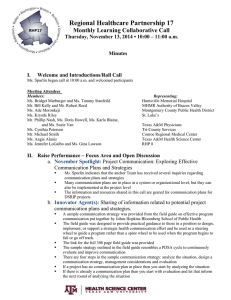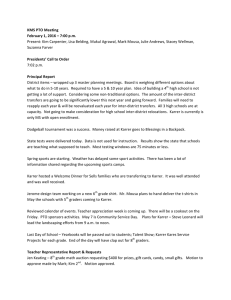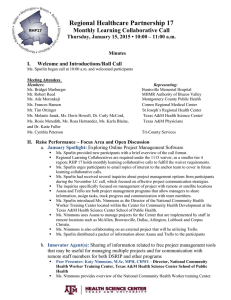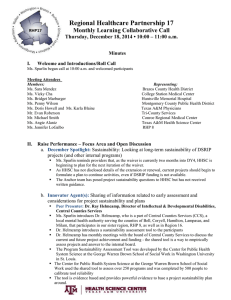Regional Healthcare Partnership 17 Monthly Learning Collaborative Call
advertisement
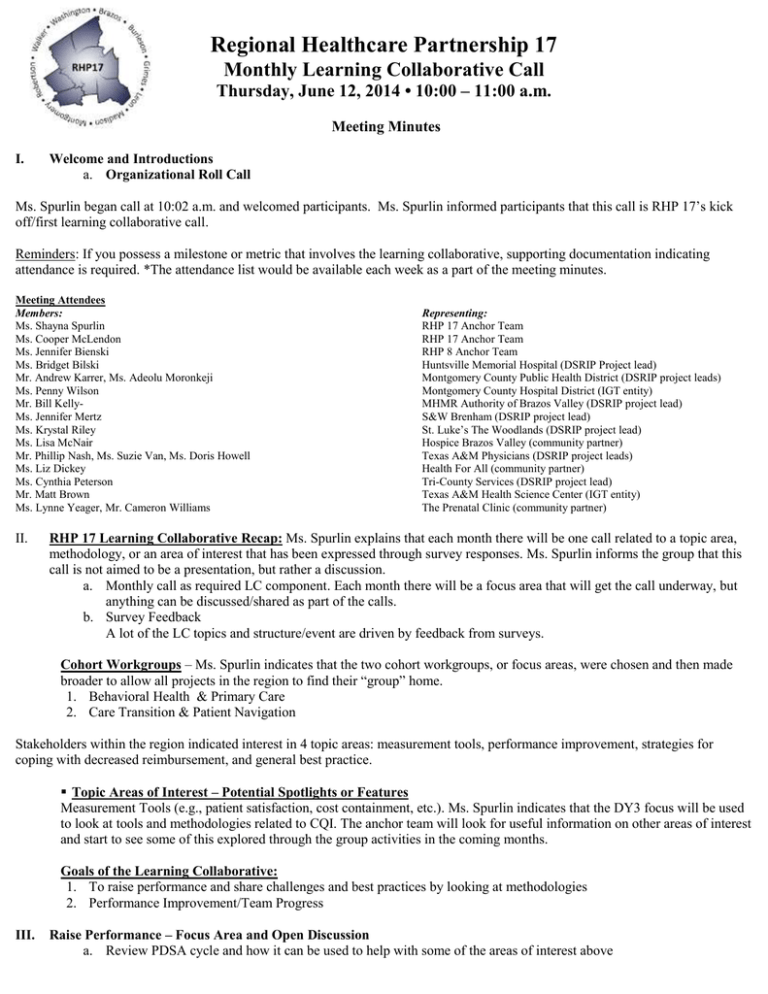
Regional Healthcare Partnership 17 Monthly Learning Collaborative Call Thursday, June 12, 2014 • 10:00 – 11:00 a.m. Meeting Minutes I. Welcome and Introductions a. Organizational Roll Call Ms. Spurlin began call at 10:02 a.m. and welcomed participants. Ms. Spurlin informed participants that this call is RHP 17’s kick off/first learning collaborative call. Reminders: If you possess a milestone or metric that involves the learning collaborative, supporting documentation indicating attendance is required. *The attendance list would be available each week as a part of the meeting minutes. Meeting Attendees Members: Ms. Shayna Spurlin Ms. Cooper McLendon Ms. Jennifer Bienski Ms. Bridget Bilski Mr. Andrew Karrer, Ms. Adeolu Moronkeji Ms. Penny Wilson Mr. Bill KellyMs. Jennifer Mertz Ms. Krystal Riley Ms. Lisa McNair Mr. Phillip Nash, Ms. Suzie Van, Ms. Doris Howell Ms. Liz Dickey Ms. Cynthia Peterson Mr. Matt Brown Ms. Lynne Yeager, Mr. Cameron Williams II. Representing: RHP 17 Anchor Team RHP 17 Anchor Team RHP 8 Anchor Team Huntsville Memorial Hospital (DSRIP Project lead) Montgomery County Public Health District (DSRIP project leads) Montgomery County Hospital District (IGT entity) MHMR Authority of Brazos Valley (DSRIP project lead) S&W Brenham (DSRIP project lead) St. Luke’s The Woodlands (DSRIP project lead) Hospice Brazos Valley (community partner) Texas A&M Physicians (DSRIP project leads) Health For All (community partner) Tri-County Services (DSRIP project lead) Texas A&M Health Science Center (IGT entity) The Prenatal Clinic (community partner) RHP 17 Learning Collaborative Recap: Ms. Spurlin explains that each month there will be one call related to a topic area, methodology, or an area of interest that has been expressed through survey responses. Ms. Spurlin informs the group that this call is not aimed to be a presentation, but rather a discussion. a. Monthly call as required LC component. Each month there will be a focus area that will get the call underway, but anything can be discussed/shared as part of the calls. b. Survey Feedback A lot of the LC topics and structure/event are driven by feedback from surveys. Cohort Workgroups – Ms. Spurlin indicates that the two cohort workgroups, or focus areas, were chosen and then made broader to allow all projects in the region to find their “group” home. 1. Behavioral Health & Primary Care 2. Care Transition & Patient Navigation Stakeholders within the region indicated interest in 4 topic areas: measurement tools, performance improvement, strategies for coping with decreased reimbursement, and general best practice. Topic Areas of Interest – Potential Spotlights or Features Measurement Tools (e.g., patient satisfaction, cost containment, etc.). Ms. Spurlin indicates that the DY3 focus will be used to look at tools and methodologies related to CQI. The anchor team will look for useful information on other areas of interest and start to see some of this explored through the group activities in the coming months. Goals of the Learning Collaborative: 1. To raise performance and share challenges and best practices by looking at methodologies 2. Performance Improvement/Team Progress III. Raise Performance – Focus Area and Open Discussion a. Review PDSA cycle and how it can be used to help with some of the areas of interest above Simplest form of CQI Many organizations and project managers do this often but may not have given it a name Primarily driven by 3 questions – what are we trying to accomplish? How will we know a change is an improvement? And what changes can we make that result in an improvement? Using all that … you set up and follow the cycle to test changes, implement changes, and then spread changes or going back to drawing board Can be done very incrementally or at a broader level Can be applied to any area and any organization type – b. Two providers will share success stories about project implementation and the use of PDSA Ms. Peterson from Tri-County Services is going to briefly share her experiences using PDSA Mr. Karrer from MCPHD has been using the PDSA cycle as an assessment and improvement tool in the implementation of the MCPHD ACP program. c. What are we doing to “Raise Performance?” Opportunity for others to share quality improvement strategies and questions/challenges: Floor opened for questions/comments from participants. None received. Call proceeded. Tri-County Services Project Spotlight Since this project was last presented in March, Ms. Peterson shared that they added more referral sources their project. The first challenge that Ms. Peterson faced was transitioning these referral sources into to a database so that the information could be more easily extracted. In order to appropriately identify referral sources, the Tri-County team asked patients via a drop-down menu, how they were referred to Tri-County Services: emergency room, medical facility, extended office of the tri-county program, selfreferrals, and community type referrals. With this information, the Tri-County team could more easily identify those who were diverted or diverted themselves to the program. At the end of the assessment, patients were further asked to identify if they were referred to other services within the community. This data is useful for the Tri-County team because it allows them to identify gaps in service. Some questions that Ms. Peterson shared as a result of their data collection include: Do we have anyone from community? Should we market there? Are we referring too many to a higher level of care? Is there something we can do differently with treatment or order to get them into routine services? Will our expanded operations reduce the number of higher level referrals? Ms. Peterson shares that it is helpful to draw data in a uniform way. Floor is open for questions: -Ms. Spurlin asks Ms. Peterson is the expansion their PDSA cycle was intentional. -Ms. Peterson indicates that the utilization of the PDSA cycle was a long-term goal with no plan. -Ms. Spurlin asks if any other providers were using the same methodology to track information or referrals. -No response received and no additional questions/comments shared, so call proceeded. Ms. Spurlin identifies that Mr. Karrer from MCHD is also using an alternative tracking method in his EHR as well, and asks him to share how he is using PDSA in his project implementation. MCHD ACP Project Spotlight Mr. Karrer provides an overview and purpose of his project: to identify those that use 911 repeatedly and excessively. Mr. Karrer shared project statistics: the highest user called 911 nearly 147 times for non-emergency issues in 2012. He explains that the ACP project is allowing MCHD to uncover the root cause of excessive ED use. He shares that over- use is not typically a result of mal intent, but EMS has done a good job of educating users about calling 911 if they have an issue which works very well, but it’s true that people’s perception of a medical emergency varies. Mr. Karrer stated that the EMS approximates 50,000 calls per year, with 23% of the call volume being individuals that call 3 or more times. The ACP project is trying to change the habits of people. He further explains that one need that was identified in this 3 year project was documentation. Although the current reporting system works well for 911 calls, Mr. Karrer indicated that the ACP program needed to be able to pull multiple records for one patient. With help from their IT department, the charting system was reprogrammed and restructured to accommodate the reporting procedures associated with this program. Mr. Karrer shared that MCHD has partnered with Zoll, their current Data Management system, to create specialized software for ACP programs, as there is not currently an EMR platform for mobile units. Mr. Karrer states that he has seen definitive results as a result of utilizing the PDSA cycle and that this particular improvement methodology permeates in everything that they do. Floor is open for questions: Ms. Spurlin shares one thing that hospitals are interested in ED diversion and asks Mr. Karrer if ED diversion is a component of his ACP program. Mr. Karrer responds by saying that the ED diversion is a part of their Category 3 measure and that it is a large component of the ACP program. He shares that MCHD is seeing about a 68% reduction in 911 uses as a result of the proactive approach of the program. Mr. Karrer states that you can’t put a financial mark on quality of life and that he is amazed at how well some of the patients have been doing as a result of this program. Floor opened for questions/comments from participants. None received. Call proceeded. IV. Learning Collaborative Updates a. New website is live - more accessible, more user friendly, LC information b. Monthly newsletter – first one went on June 10th; formatting issues corrected by IT. The monthly newsletter will be sent to the Master Distribution list. If you are not interested in receiving the newsletter, you may unsubscribe. You will still receive regional updates via email from the Anchor team. c. Cohort group development to take place in June – goal of first formal group meetings kicking off in July d. Discussion group live next week (week of June 16th) – email list type of group exchange set up through Google groups. We will prepopulate the group with those of you that signed up at the March 27th event. A quick reference guide will be sent with information on how to access and post to the group. Anyone else interested in joining can contact us via email, through the website to sign up. e. Next Event -- Webinar/Speaker series slated for end of June/ early July during lunch (Cooper to give a presentation on Six Sigma) More information to come. f. Second Face-to-face event will be held in August 2014. More information will be coming soon with a save-the-date calendar appointment in the next couple of weeks! g. Lastly – HHSC Event will be held September 9-10 in Austin. As we get more details, we will share those. We do know the event is limited to 500 people and they will probably limit number of attendees from each Region. Floor is open for questions/comments: Ms. Peterson indicated that she would like program updates from other providers to see who is implementing similar projects and experiencing challenges. Ms. Spurlin replies by saying that the main purpose of the call is for providers to share challenges and program updates. The newsletter will also be a great tool that will allow us to highlight projects and the cohort workgroups will also be a great resource for information sharing as well. V. Next Steps & Adjourn a. Next Steps … Anchor: 1. As we prep for the cohort groups, we will send out copies of the signed commitment cards we received so people know what they signed up for. 2. We will send out group packet info to volunteer facilitators/co-facilitators 3. We will share information and access instructions for the Discussion Group next week 4. We will share info about the upcoming webinar in the next week to 10 days, once we have set up finalized with IT. Stakeholders: Sign up for and participate in the discussion group Plan to participate in cohort work groups and invite community partners to participate as well Send the Anchor your successes so we can celebrate those and highlight regional achievements Send us information about events you are hosting or attending b. Next call scheduled for Thursday, July 10, 2014 at 10 a.m. – Recapping Six Sigma and any new topics you want to share Thank you for participating. We look forward to working with everyone on 1115. Please feel free to share ideas/suggestions for Learning Collaborative discussion topics (email Cooper at cmclendo@sph.tamhsc.edu)
